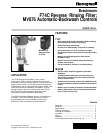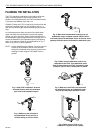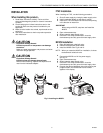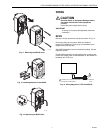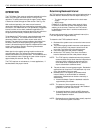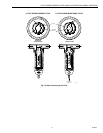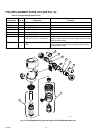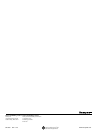
F74C REVERSE RINSING FILTER; MV876 AUTOMATIC-BACKWASH CONTROLS
62-3061 8
OPERATION
The F74C Water Filter removes sediment and debris from the
water using an upper and lower screen. During normal
operation, no water passes through the upper screen. Water
is filtered as it flows through the lower screen. See Fig. 15a.
With continued operation, the lower screen becomes
obstructed, reducing efficiency and creating a pressure drop
across the F74C. Backwash the F74C periodically. Suggested
interval is either once a week (residential applications) or
when the pressure gauge measures about five psi lower than
the pressure when initially installed (with similar flow).
To backwash the F74C manually, open the backwash outlet
on the F74C bottom. This forces the entire filter insert
downward. Water flow to the lower screen outer side is
blocked. The upper filter removes sediment and debris from
the water. Some of the water passing through the upper
screen is directed through the impeller to backwash the lower
screen (from inside to outside). Remaining filtered water
meets the needs downstream.
Water jets from the rapidly spinning impeller enhance the
reversed water flow. The reverse flow removes trapped
sediment and debris from the lower filter. This sediment drains
out the backwash outlet. Cleaning the lower screen requires
approximately 20 seconds. See Fig. 15b.
The F74C requires no maintenance, in most applications, if
backwashed at the proper interval.
Determining Backwash Interval
All F74C applications are different and require backwashing at
different intervals. Backwash intervals depend directly on:
— The level and type of sediment in the local water
supply.
— Water usage.
EXAMPLE: In northern states, water usage is higher
in summer months than in winter months due to lawn
watering in the summer. Therefore, the F74C should
be backwashed more often in summer months than in
winter months.
By accurately determining a proper backwash interval, the
F74C will operate at a higher efficiency.
To determine the F74C backwash interval:
1.
Backwash the system once to ensure the lower screen
is clean.
2.
The pressure gauge needle measures outlet pressure.
With clean screens, inlet pressure should never be
more than 7 psi higher than the outlet pressure.
3.
Record the date, time and pressure reading.
4.
Monitor the F74C closely. Over time, the screens
become obstructed and the outlet pressure drops.
NOTE: The F74C requires a backwash when the pressure
measures about five psi lower than the inlet pressure
did when initially installed (at approximately the
same water flow). Installations do vary and can
require a backwash at different times.
5.
Record the date, time and pressure again. Residential
applications can require an F74C backwash only once
every few weeks to once per week.
6.
Backwash the F74C regularly at the determined
interval. Weekly is recommended for residential
applications. A backwash can be done manually or
automatically:
a. Manual backwash: Open the backwash outlet for
approximately 30 seconds.
NOTE: The amount of time required varies among
installations. However, 30 seconds is the standard
guideline to clean the lower screen.
b. Automatic backwash: Install an M876 Automatic
Backwash Valve and select the backwash interval.
See the Operation section.
NOTE: Backwashing more frequently than actually required
will not harm the system or the filter.



